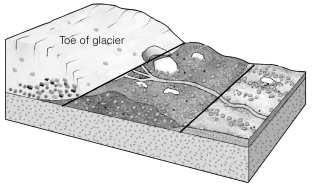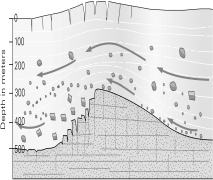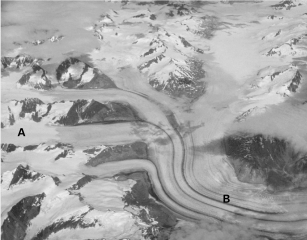A) the differences in how land and ice respond to the daily input of solar energy
B) the winds that occur along cold fronts near glaciers
C) the winds that blow from nearby lands onto colder glaciers
D) the high absorbitivity of sunlight by ice
Correct Answer

verified
Correct Answer
verified
Multiple Choice
The figure below shows the toe of a glacier.What is the gray feature that is between the two heavy black lines? 
A) the zone of accumulation
B) an esker
C) a moraine
D) an arete
Correct Answer

verified
Correct Answer
verified
Multiple Choice
Ice reflects solar radiation (sunlight) very well,whereas water absorbs it.As the Arctic sea ice cover shrinks year after year,what effect will this have on the amount of heat retained in the Arctic?
A) None
B) The amount of heat retained will slowly decrease.
C) The amount of heat retained will slowly increase.
D) There is very little effect, because the steeply angled incoming solar radiation will evaporate seawater, resulting in an extensive cloud cover over the Arctic Ocean.
Correct Answer

verified
Correct Answer
verified
Multiple Choice
The formal definition of an iceberg is ______________.
A) a detached piece of continental ice sheet found floating in open water
B) a free-floating piece of ice at least 15 m long and rising at least 6 m above the water surface
C) a piece of any ice sheet floating in marine water
D) All of the above are correct.
Correct Answer

verified
Correct Answer
verified
Multiple Choice
At the present,glaciers cover about ____________ of the surface of the continents.
A) 1%
B) 5%
C) 10%
D) 20%
Correct Answer

verified
Correct Answer
verified
Multiple Choice
Silt-sized particles transported hundreds of km or more and deposited in sometimes thick layers during the ice ages are ____________.
A) firn
B) loess
C) outwash
D) till
Correct Answer

verified
Correct Answer
verified
Multiple Choice
Which of these processes contributes the most to the formation of ice-margin lakes?
A) glacial subsidence
B) erosion of loess
C) moraine retreat
D) glacial rebound
Correct Answer

verified
Correct Answer
verified
Multiple Choice
The primary reason that glacial till is rarely bedded is that ____________.
A) waters flowing near glaciers moves chaotically rather than in laminar flow
B) the irregular calving and breakup of glaciers disturbs waters and sediment layers and generally inhibits preservation of bedding that forms in between those events
C) sediment tends not to form beds in cold waters
D) glacial sediment is generally deposited by the melting of ice under and around it
Correct Answer

verified
Correct Answer
verified
Multiple Choice
An important long-term factor determining whether glacial ice will form on the continents may be the proportion of which gas in the atmosphere?
A) oxygen
B) nitrogen
C) carbon dioxide
D) carbon monoxide
Correct Answer

verified
Correct Answer
verified
Multiple Choice
The first scientist to theorize the past presence of glaciers in Europe was ____________.
A) Isaac Newton
B) Charles Darwin
C) Walter Alvarez
D) Louis Agassiz
Correct Answer

verified
Correct Answer
verified
Multiple Choice
In a glacier,which of the following decreases with increased depth into ice,and/or age of ice?
A) the amount of sediment and rock particles found within it
B) porosity
C) loess content
D) the oxygen-18 (18O) content
Correct Answer

verified
Correct Answer
verified
Multiple Choice
A bowl-shaped depression formed by a mountain glacier is termed a(n) ____________.
A) arête
B) cirque
C) horn
D) tarn
Correct Answer

verified
Correct Answer
verified
Multiple Choice
Keeping in mind that ice is a mineral,why can a glacier be considered a metamorphic rock?
A) because it is formed by increased pressure and temperature
B) because it is inorganic
C) because it significantly changes in both shape and texture while in the solid state
D) because it is formed by hydrothermal alteration of existing minerals
Correct Answer

verified
Correct Answer
verified
Multiple Choice
A hanging valley exists where a ____________.
A) smaller glacially carved valley intersects a larger, deeper glacially carved valley
B) smaller stream-cut valley intersects a larger stream-cut valley
C) smaller stream-cut valley intersects a larger glacially carved valley
D) stream-cut valley is on the upthrust side of a normal fault
Correct Answer

verified
Correct Answer
verified
Multiple Choice
Firn consists of ____________.
A) ice crystals with approximately 25% air
B) ice crystals with 20% or less air
C) ice that has been buried deeply enough to flow ductilely, but is now shallow enough to behave brittlely
D) ice with entrained sediment
Correct Answer

verified
Correct Answer
verified
Multiple Choice
Mars has polar ice caps that differ from the Earth's Antarctic ice cap in that ____________.
A) the Martian caps contain some frozen carbon dioxide (dry ice) as well as ice water
B) the Martian caps have a spiral fracture pattern not found in Antarctica
C) Martian caps are ablated by sublimation only; there is currently no liquid water on Mars
D) All of the above are correct.
Correct Answer

verified
Correct Answer
verified
Multiple Choice
A boulder that is found in an unlikely place and/or has a different composition than the underlying or nearby rock is possibly a(n) ___________.
A) kame
B) erratic
C) arête
D) ventifact
Correct Answer

verified
Correct Answer
verified
Multiple Choice
In the glacier below,approximately how deep is the transition from brittle to ductile deformation? 
A) 10 m
B) 60 m
C) 100 m
D) 250 to 300 m
Correct Answer

verified
Correct Answer
verified
Multiple Choice
Which location is most likely the site of ablation,A or B? 
A) A
B) B
C) They are equally likely.
D) The answer cannot be determined from the information given.
Correct Answer

verified
Correct Answer
verified
Multiple Choice
A glacier will advance from its source area if the rate of accumulation is greater than the rate of ____________.
A) subsidence
B) melting
C) ablation
D) abrution
Correct Answer

verified
Correct Answer
verified
Showing 41 - 60 of 60
Related Exams